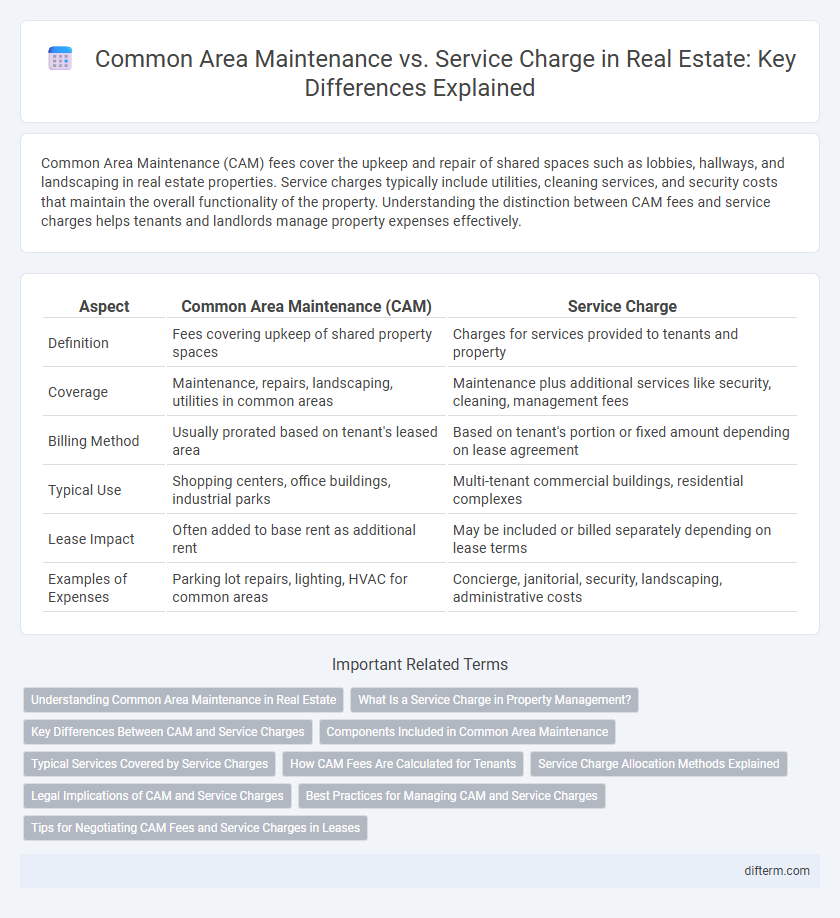Common Area Maintenance (CAM) fees cover the upkeep and repair of shared spaces such as lobbies, hallways, and landscaping in real estate properties. Service charges typically include utilities, cleaning services, and security costs that maintain the overall functionality of the property. Understanding the distinction between CAM fees and service charges helps tenants and landlords manage property expenses effectively.
Table of Comparison
| Aspect | Common Area Maintenance (CAM) | Service Charge |
|---|---|---|
| Definition | Fees covering upkeep of shared property spaces | Charges for services provided to tenants and property |
| Coverage | Maintenance, repairs, landscaping, utilities in common areas | Maintenance plus additional services like security, cleaning, management fees |
| Billing Method | Usually prorated based on tenant's leased area | Based on tenant's portion or fixed amount depending on lease agreement |
| Typical Use | Shopping centers, office buildings, industrial parks | Multi-tenant commercial buildings, residential complexes |
| Lease Impact | Often added to base rent as additional rent | May be included or billed separately depending on lease terms |
| Examples of Expenses | Parking lot repairs, lighting, HVAC for common areas | Concierge, janitorial, security, landscaping, administrative costs |
Understanding Common Area Maintenance in Real Estate
Common Area Maintenance (CAM) in real estate refers to fees tenants pay for the upkeep and repair of shared spaces such as hallways, lobbies, parking lots, and landscaping in commercial properties. CAM charges are typically calculated based on the tenant's leased square footage and cover expenses including janitorial services, security, and maintenance of common utilities. Understanding CAM is crucial for tenants to anticipate operational costs beyond base rent and avoid unexpected financial obligations in lease agreements.
What Is a Service Charge in Property Management?
A service charge in property management refers to the fee landlords or property managers collect from tenants to cover the costs of maintaining and operating common areas such as lobbies, elevators, landscaping, and security systems. This charge ensures shared expenses like cleaning, repairs, and utilities for communal spaces are fairly distributed among all tenants. Clear definitions of service charges help prevent disputes by detailing specific maintenance activities and associated costs within lease agreements.
Key Differences Between CAM and Service Charges
Common Area Maintenance (CAM) fees specifically cover expenses related to the upkeep and repair of shared spaces such as lobbies, hallways, and landscaping within commercial properties. Service charges often encompass a broader range of operational costs, including utilities, security, and administrative services alongside maintenance. Understanding that CAM fees are a subset focused on physical maintenance while service charges represent comprehensive property management costs is crucial for accurate budgeting in real estate leases.
Components Included in Common Area Maintenance
Common Area Maintenance (CAM) charges primarily cover expenses related to the upkeep and repair of shared spaces such as lobbies, hallways, elevators, parking lots, landscaping, and building security systems. These charges often include costs for cleaning services, lighting, HVAC maintenance, property management fees, and insurance for common areas. CAM fees are distinct from service charges, which may encompass utilities and other operational costs not directly tied to physical maintenance.
Typical Services Covered by Service Charges
Service charges in real estate typically cover maintenance and repairs of common areas, utilities such as lighting and water, security services, and landscaping. These charges also include expenses related to cleaning shared spaces, elevator servicing, and building insurance. Understanding these services helps tenants and property managers allocate costs fairly and maintain property value.
How CAM Fees Are Calculated for Tenants
CAM fees for tenants are typically calculated based on the tenant's pro-rata share of the property's total leasable area, multiplied by the total common area maintenance expenses incurred by the landlord. These expenses often include costs for landscaping, security, janitorial services, and building repairs, which are divided among tenants according to their leased square footage. Service charges may encompass CAM fees but can also cover additional operational costs such as utilities and administrative expenses, making precise CAM fee calculation essential for transparent tenant billing.
Service Charge Allocation Methods Explained
Service charge allocation methods in real estate typically involve dividing costs based on leased area, property usage, or occupancy percentage to ensure fair distribution among tenants. Pro-rata allocation charges each tenant according to their leased square footage relative to the total property size. Another method, fixed allocation, assigns a predetermined fee regardless of space, while variable allocation adjusts charges based on specific service usage or benefit derived by each tenant.
Legal Implications of CAM and Service Charges
Legal implications of Common Area Maintenance (CAM) and service charges often hinge on lease agreements and local property laws, requiring clear definitions of responsibilities and cost allocations. CAM charges typically cover maintenance and repair of shared spaces, while service charges may include broader expenses such as security and utilities, both subject to statutory regulations and tenant-landlord dispute resolution mechanisms. Failure to comply with legal standards in managing CAM and service charges can lead to tenant claims, regulatory penalties, and costly litigation.
Best Practices for Managing CAM and Service Charges
Effective management of Common Area Maintenance (CAM) and service charges requires clear lease agreements detailing cost allocation and periodic reconciliations to ensure transparency. Implementing detailed accounting practices and regular communication with tenants helps prevent disputes and fosters trust. Utilizing property management software streamlines tracking expenses and enhances reporting accuracy for CAM and service charges.
Tips for Negotiating CAM Fees and Service Charges in Leases
Understanding the distinctions between Common Area Maintenance (CAM) fees and service charges is crucial for effective lease negotiations in commercial real estate. Tenants should request detailed breakdowns of CAM expenses and ensure caps or fixed fee structures are included to avoid unexpected increases. Conducting regular audits and negotiating clear definitions of covered services can significantly reduce disputes and control overall occupancy costs.
Common Area Maintenance vs Service Charge Infographic

 difterm.com
difterm.com